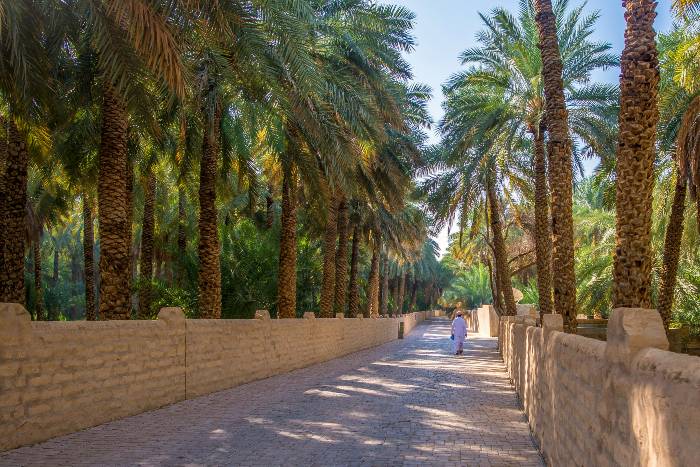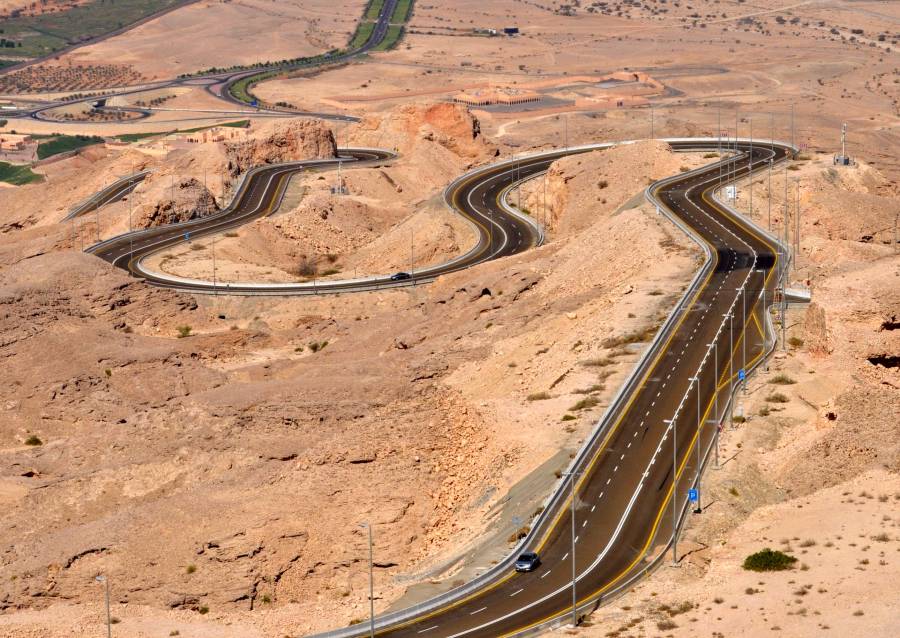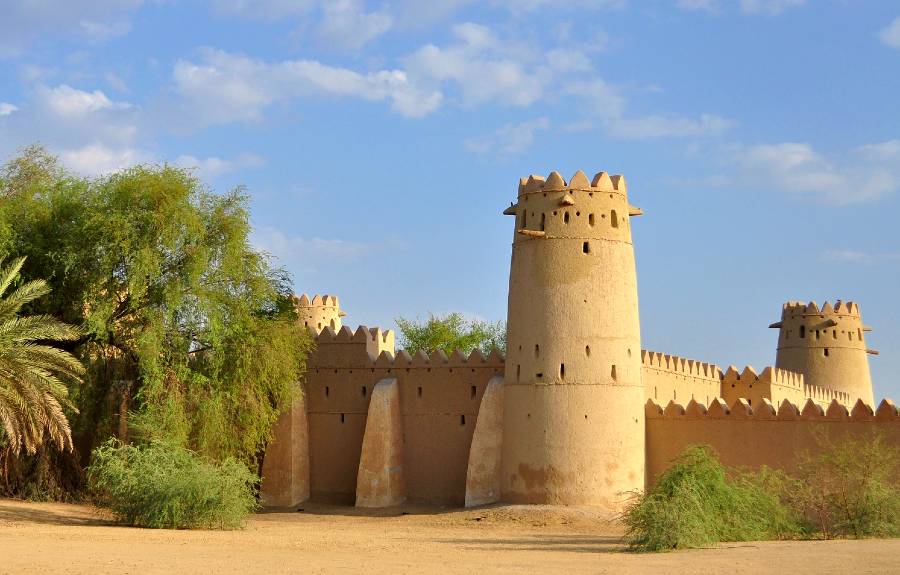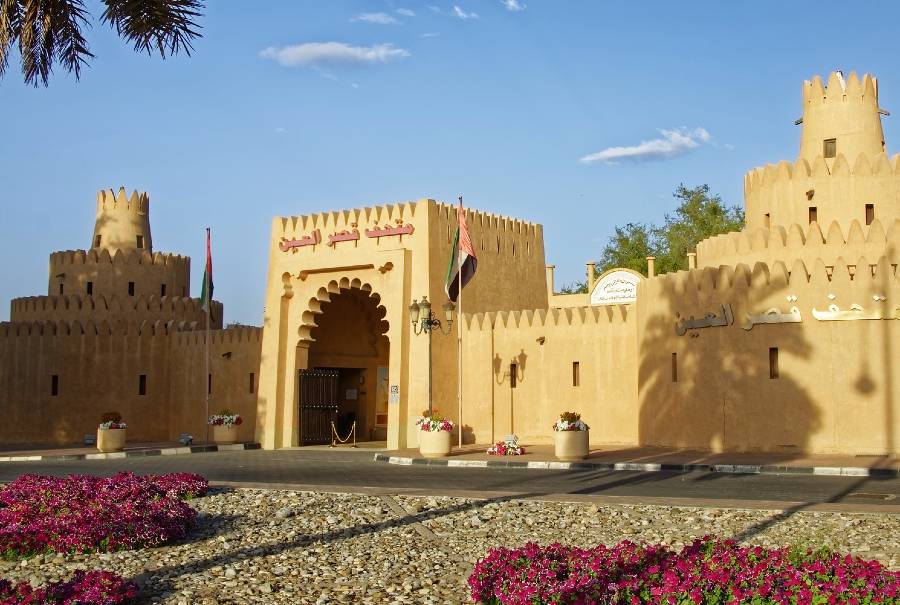Al Ain is one of the most authentic and interesting cities in the UAE. Also known as Garden City or Oasis City, it arose around a lush green oasis in the middle of the desert, surrounded by the Jebel Hafeet mountains, right along the border with Oman.
Today Al Ain is one of the must-see destinations for a trip to the UAE, easily accessible from Dubai and Abu Dhabi and full of history, ancient fortresses, gardens, palm tree-covered oases and breathtaking views.
Read the complete guide, or go straight to the point:
- Explore Al Ain, the only UNESCO’s World Heritage site in the UAE
- Best Places to Visit and Things to Do in Al Ain
- Best Al Ain Hotels
- Where to Eat in Al Ain
- How to get to Al Ain
Explore Al Ain, the only UNESCO’s World Heritage site in the UAE
Al Ain is a quiet city, surrounded by rough and dusty mountains, and located in the middle of the desert. The border with Oman passes right in the center of Al Ain, and from here you can go to the nearby city of Al Buraimi and perhaps continue towards Muscat, driving through one of the most authentic and wild sceneries of this corner of Arabia.
Al Ain, whose roots go back to the Neolithic era, about 8000 years ago, is the only site in the United Arab Emirates to be present in the UNESCO’s World Heritage List.
Al Ain was once an important oasis along the route of caravans traveling through the harsh Rub ‘al-Khali desert, the so-called Empty Quarter, the largest sandy desert in the world.


The merchants stopped in this cool and shady oasis to rest the camels, stock up on water that gushed from the springs that can still be visited today, and stock up on abundant and delicious local products.
In recent history, the founding father of the UAE, Sheikh Zayed bin Sultan Al Nahyan, grew up in Al Ain. His son, Sheikh Khalifa bin Zayed bin Sultan Al Nahyan, current president of the UAE and ruler of Abu Dhabi, was also born in Al Ain.
Al Ain today is part of the Emirate of Abu Dhabi, from which it is approximately 130 km (81 mi). Dubai is roughly a similar distance away.
Best Places to Visit and Things to Do in Al Ain
Al Ain today has over 600,000 inhabitants, but has kept its authentic charm and peaceful atmosphere quite intact. Many people choose to visit it on a day trip from Dubai or from Abu Dhabi, while others choose to enjoy this wonderful area more calmly by staying in one of its fabulous resorts. So… let’s find out which are the places to visit that you just can’t miss!
Jebel Hafeet
The Jebel Hafeet is a 1.240-meter-high mountain, overlooking the city of Al Ain. It is considered the second highest peak in the UAE (after Jebel Jais in Ras Al Khaimah) and from here you can admire a breathtaking view of the city of Al Ain and the immense desert that surrounds it.
At the foot of Jebel Hafeet it is possible to explore the remains of ancient prehistoric tombs (to reach them, however, you need a good off-road vehicle), while if you want to take some amazing photos, go up to the top of the mountain.
To reach the top of Jebel Hafeet there is a comfortable and wide panoramic road, which is undoubtedly one of the most scenic in the UAE. From the center of Al Ain to the summit it is about 55 km, the road is a bit steep and winding, and offers many vantage points from which you can enjoy incredible views over the entire region.
On the top of Jebel Hafeet there is a palace belonging to the ruling family, and nearby is the Mercure Grand Jebel Hafeet, one of the best and most scenic hotels in Al Ain.

Al Ain Oasis
The Al Ain Oasis is one of the most amazing and authentic places you can visit in the UAE. There are 7 different oases in Al Ain, totaling around 150,000 palm trees that produce the best dates in the entire region.
Palm trees grow in a series of plantations irrigated by water canals, using the famous Falaj irrigation system, which has been in use for over 3,000 years.
The Al Ain Oasis is located in the heart of the city, and can be visited for free. You can enjoy a peaceful and relaxing stroll along the myriad of footpaths that wind their way through the plantations.
The most interesting oases to visit are the one located between the Al Ain Palace Museum and the Al Ain National Museum, and that of Al Qattara, near the old souk. The latter also preserves several ancient fortresses.
Green Mubazzarah Park
Green Mubazzarah Park is undoubtedly a favorite spot for locals, who come here to relax and enjoy a picnic with the family.
This oasis is located in the middle of a rocky and arid area, which makes it particularly scenic. People come from all over the region, including neighboring Oman, to soak in the hot springs that flow into Green Mubazzarah Park.
From ancient springs gushes a natural mineral water, which is quite hot, which the locals believe has particular healing properties, especially for the bones, muscles and nervous system. Hot water flows through the park and then forms a series of pools, where you can soak if you want.
Al-Jahili Fort
Al-Jahili Fort is arguably the most iconic building in Al Ain, and is one of the most interesting places to understand its fascinating history.
Nestled in a lush green garden, this wonderful fortress dating back to 1891 looks like a picturesque sandcastle. Well, it’s actually a sandcastle.
It played an important defensive role for the city and was the headquarters of the forces of the Oman Trucial Scouts, who for decades maintained the peace between the different local tribes who ruled the area.
Inside you can also visit an interesting exhibition dedicated to Sir Wilfred Thesiger, a British military officer, explorer and travel writer, who in the 1940s crossed the Rub ‘al Khali desert with a group of Bedouins, from the south coast of Oman to Abu Dhabi.

Al Ain Zoo
One of the most interesting things to do in Al Ain is a visit to the Al Ain Zoo, the largest and most important in the UAE, famous for its commitment to research and protection of endangered species.
Opened in 1969, the Al Ain Zoo is home to local mammals, such as the Arabian antelope and Arabian oryx, as well as wonderful African mammal specimens, such as giraffes, zebras, gazelles, lions, tigers, jaguars and monkeys.
The Al Ain Zoo has a major research facility, specializing in breeding and conservation programs for local endangered species, which account for over 30% of the animals housed in the zoo.
A visit to the Al Ain Zoo is definitely a must for families, who can admire these wonderful animals grazing freely in an area of over 200 hectares, participating in a guided tour aboard special vehicles.
Qasr al Muwaiji
Among the fortresses that can be seen in Al Ain, the recently restored Qasr al Muwaiji is one of the most beautiful.
Built in the early 1900s, it was the home of the UAE’s founding father, Zayed bin Sultan Al Nahyan. Here the sheikh lived with his family, and is the place where his son, Sheikh Khalifa, current president of the UAE and ruler of Abu Dhabi, was born.
Inside there is a small museum on the history of the fort and on the life of the ruling family.
Camel Market
This is certainly one of the most authentic and fun places to get in touch with the local culture. The Al Ain Camel Market is a dirty, smelly, and chaotic place that you definitely can’t miss: camel sellers from all over the Middle East come here to sell their camels.
The market is always quite crowded with local buyers, who come here to see the animals and haggle to buy some.
Most camels, especially the younger ones, are bought for their meat. Locals love camel meat. When a local family is planning a wedding celebration, it is customary to come here and buy a camel, which will surely end up on the grill.
This is the last remaining camel market in the UAE, making it a must experience for travelers.
You can visit it for free: ignore the people who approach you insisting that you need a guide, they just want to get some money. When you visit Camel Market you can safely watch people bargain, but don’t interfere and respectfully keep your distance. It is important to ask people for permission before taking a picture (this is also true if you just want to photograph someone’s camels).
Al Ain Palace Museum
The fort that now houses the Al Ain Palace Museum was once the ancient royal palace, where Sheikh Zayed bin Sultan and his family lived until 1966, before moving to Abu Dhabi.
The palace has been restored and restored to its former glory, so that today it is possible to realize exactly how it was when the Sheikh lived there. Its gardens and decorations are a prime example of classic Emirati architecture.

Al Ain National Museum
Right on the edge of the Al Ain Oasis, is the Sultan Bin Zayed Fort, an ancient fortress that now houses the Al Ain National Museum.
This museum is dedicated to the cultural and historical heritage of the region, with several exhibits dedicated to local life and traditions.
The museum also houses an interesting archaeological section that collects artifacts dating back to the Bronze and Iron Ages from the nearby Hili Archaeological Park.
Camel Racing
Did you know that camel racing is the national sport of the UAE? This is an ancient tradition, which is carried on by many local men, including sheikhs and important people.
For a traveler, seeing a camel ride is a rare opportunity to discover the local culture. To find out if there is a ride on the day of your visit, ask your guide or the locals.
In Al Ain there is a 10-kilometer track dedicated to camel racing and hundreds of enthusiasts come here from all over the region for the races.
Green Gardens and Old Souks
Al Ain is also known as Garden City, and this is due to its green gardens, parks and oases. One of the most beautiful gardens to visit is the Hili Archaeological Park, which is especially popular with local families who go there for picnics or to relax.
In this garden you can admire fountains and incredible and colorful floral compositions.
Another place worth seeing is the Al Qattara Old Souk, located on the edge of the Al Qattara Oasis. This traditional souk dates back to the mid-1900s, and especially on weekends it is a great place to meet local artisans and buy handicrafts, spices, dates, coffee or some local specialties.
Best Al Ain Hotels
Al Ain is an excellent destination for those who want to enjoy a few days in total relaxation, in one of the calmest and most pleasant cities in the United Arab Emirates.
If you are thinking of spending a few days in Al Ain, then you should check out these hotels:
Telal Resort Al Ain
The Telal Resort Al Ain is the perfect place to spend an unforgettable stay. It is located in the middle of the desert, about 30 km from the city center of Al Ain, surrounded by a breathtaking landscape, made up of small oases and ponds.
It offers accommodations in splendid villas, a wellness center, swimming pools and a good restaurant serving international cuisine.
Al Ain Rotana
The Al Ain Rotana hotel is one of the best choices for families and travelers who plan to stay a few days to visit the city.
It is located in the city center, close enough to all the main places to visit in Al Ain. It offers comfortable rooms, a beautiful swimming pool, free private parking and a good restaurant serving local and international dishes.
Mercure Grand Jebel Hafeet
The Mercure Grand Jebel Hafeet is a wonderful hotel located over 900 meters high, on the top of the Jebel Hafeet.
It offers comfortable rooms, three good restaurants and two bars where you can sip a cocktail while enjoying the incredible view over the whole city of Al Ain and the boundless desert.
Do you want to stay in Al Ain? Discover the Complete Guide to the Best Hotels and Resorts in Al Ain!
Where to Eat in Al Ain
Most travelers arrive in Al Ain on a day tour from Dubai or from Abu Dhabi, which usually also includes a great and hearty lunch included.
Those traveling on their own, however, have a good variety of choice of places to eat in Al Ain.
One of the most popular choices is the Ayla Restaurant, located in the Ayla Hotel, which offers an excellent buffet of local and international specialties, seafood, meat and good vegetarian options.
While at the Ayla Grand Hotel (don’t confuse them, they are two different hotels) you can try the Nara Restaurant with its buffet of excellent international cuisine, especially Indian and Oriental.
To taste some typical local specialties, there is no doubt: go to Al-Fanar Restaurant & Cafe. In this restaurant you will have the feeling that you are in an ancient fortress in the desert, like the ones that once housed the caravans. It will be like stepping back to the mid-1900s, and you will be the explorer. The food is great, the prices are okay.
How to get to Al Ain
Al Ain is approximately 130-160 km (depending on the area) from Abu Dhabi and Dubai and is well connected by roads that cross the desert, but which are paved and in very good condition.
The easiest and cheapest way to get there is to rent a car in Dubai or Abu Dhabi (here you will find some useful info on the most reliable and affordable car rentals), and enjoy the extraordinary road trip in complete freedom.
Most travelers choose to visit Al Ain on a guided day tour from Dubai or Abu Dhabi. This can be a great choice, because it allows you to enjoy the city to the fullest and without worries.
There is also the E201 bus which connects Dubai to Al Ain, departing from the Al Ghubaiba bus station. Departures are every 30 minutes and the journey lasts 2 to 2.5 hours, priced at AED 25 one way.
Those traveling from Abu Dhabi can take the X90 bus, which goes from Abu Dhabi Central Bus Station directly to Al Ain Central Bus Station. The journey takes about 2 hours, the one way ticket costs 25 AED.
However, consider that the city of Al Ain is quite large, and to visit it you will need to go around by taxi.
Undecided on how to get there? Here is an in-depth guide on the best ways to get from Dubai to Al Ain!
Discover interesting things to do near Al Ain:
If you want to find out more about the Jebel Hafeet, its scenic mountain road, and the UNESCO-listed prehistoric tombs, here is the complete guide to visiting the Jebel Hafeet.
Planning your trip to Abu Dhabi? Then you should check out the GUIDE TO THE BEST THINGS TO DO AND SEE IN ABU DHABI.